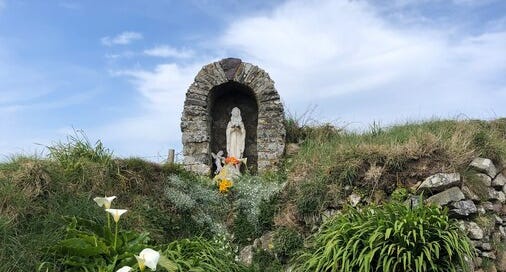What the Romans did to us
‘The Celtic Alternative: A reminder of the Christianity we lost’ (Shirley Toulson, 1987)
In AD 664, King Oswiu of Northumbria convened a synod at the monastery of Streonshalh, later known as Whitby Abbey. There were two key questions on the agenda: how should the date of Easter be calculated? And what kind of tonsure should monks wear? These topics were not as trivial as they might seem. The timing of Easter and official tonsure style were symbolic points of division between the Churches of Rome and the Celtic world. To choose between them was to choose one’s allegiance to an entire branch of Christianity. In the end, Oswiu chose to follow the Roman tradition.
According to writer and poet Shirley Toulson (1924–2018), the Council of Whitby is where it all went wrong. In her largely forgotten 1987 book The Celtic Alternative: A reminder of the Christianity we lost, Toulson describes a Celtic Church that flourished across Britain and Ireland in the centuries after the retreat of the Roman Empire. She argues that this was a Church grounded in a humble respect for humanity and nature. It was the Church of Columba, Dewi and Brigid: one that blended Christian and Druidic (and other) traditions to formulate a faith marked by ‘tolerance, persistence and a tough but gentle kindliness’ — far removed from the urban, institutionalised Church of Rome.
Toulson’s rehabilitation of the Celtic Church was driven by contemporary anxieties. The Celtic Alternative reflects the existential fears of the 1980s: this was the era of Greenham Common, of Chernobyl and the ‘Star Wars’ programme. Toulson makes constant asides about mankind’s destruction of the world, arguing that the Celtic Church can teach us much about respect for the earth and humanity at a time when neither is held in high regard. These comments can feel clumsy, but these issues haven’t gone away.
Some of the book’s other themes are less convincing. A major premise of The Celtic Alternative is that the Celtic Church inherited not only Druidic traditions (which is widely evidenced) but also those of Judaism and the Egyptian Coptic Church. Perhaps this is true, but Toulson’s argument relies heavily on coincidence and supposition (she even admits to finding no evidence of Jews remaining in Britain after the Romans left). There’s much guesswork, but little substance.
One might equally question whether such a thing as a ‘Celtic Church’ ever existed. Historians avoid the term, arguing that, while there may have been common features to Christian worship across the Celtic peoples, there was no formal unity. Moreover, this was the case everywhere. The papacy may have been based in Rome, but there was enormous geographical variation in Christian practice across Europe in the Early Middle Ages. Whitby was not a pitched battle between the Roman and Celtic Churches, as Toulson suggests, but rather part of a slow process of suppressing local idiosyncrasies across Christendom.
For all its clumsy arguments and historical anachronisms, however, The Celtic Alternative remains a valuable book. Toulson was no historian, but there is some truth in her argument that modern Western ‘civilisation’ has abandoned any meaningful connection to nature and humanity. As Toulson herself comments:
Many people in the established institutions find the doctrines and practices of the Celtic Church […] both crabbed and quirky. In the same way many of the rituals of the Buddhist monasteries can strike Western people as raucous and incomprehensible: for neither Celts nor Buddhists are geared into our tight timescales and logical systems of technology. That does not mean that they cannot show us a way out of the confusion that human intellect divorced from feeling has led us into.
The Celtic Alternative should not be treated as a work of history, nor of theology. Instead, it should be read as a call to arms. As an indictment of technocratic institutions and the destruction they wreak — and as a hopeful call for a more cooperative and meaningful existence — it remains curiously powerful.




